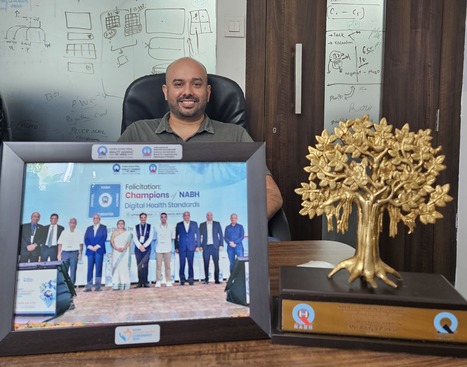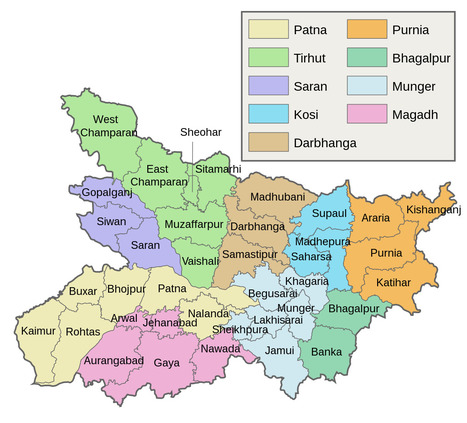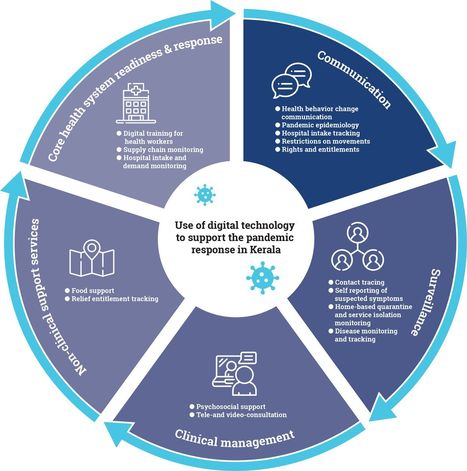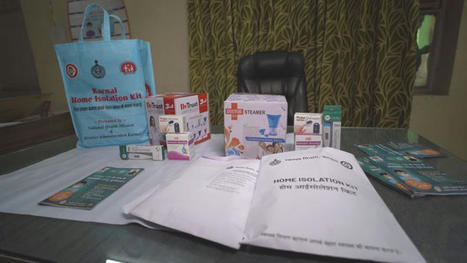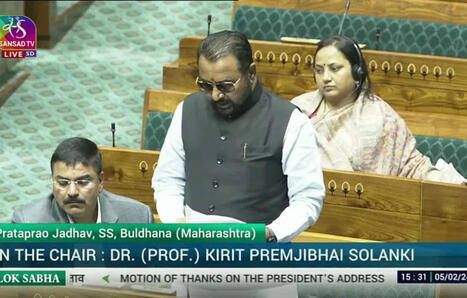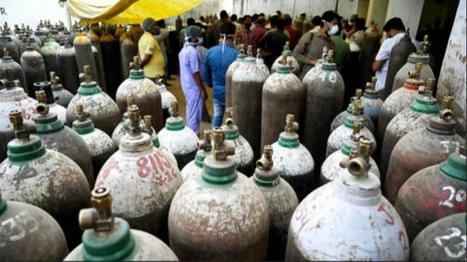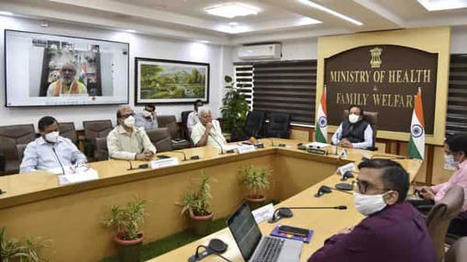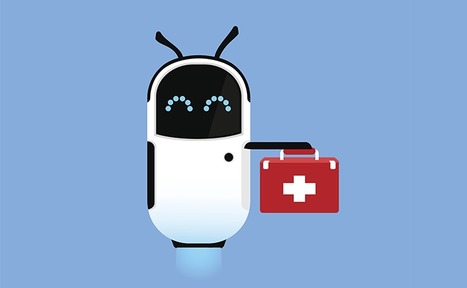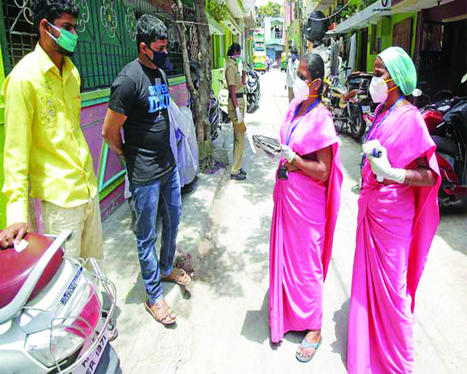 Your new post is loading...
 Your new post is loading...

|
Scooped by
nrip
September 19, 2024 11:48 PM
|
Aditya Patkar, CEO at Plus91 Technologies, honored as a Digital Health Champion at the NABH Patient Safety Conference organized by the Quality Council of India (QCI) in New Delhi on the 18th of September 2024 The NABH Patient Safety Conference is a renowned event that brings together healthcare professionals, policymakers, and thought leaders to discuss and promote best practices in patient safety. The Digital Health Champion award, presented by QCI, recognizes individuals who have made significant strides in advancing digital health and improving patient care outcomes. Aditya Patkar's recognition as a Digital Health Champion underscores Plus91 Technologies' commitment to revolutionizing healthcare delivery through its comprehensive suite of AI-driven solutions. Under Mr. Patkar's visionary leadership, Plus91 Technologies has developed cutting-edge technologies, including electronic medical records, telehealth services, practice management tools, and patient engagement platforms, all designed to enhance patient care and operational efficiency.

|
Scooped by
nrip
November 9, 2024 1:55 AM
|
Across India’s vast healthcare network, which relies heavily on more than two million hospital beds, traditional methods of patient monitoring in general wards largely depend on periodic manual checks. This conventional system often leads to delayed detection of health deterioration, leaving many vulnerable patients at risk. A recent study published in Frontiers in Medical Technology (FMT) indicates that this scenario might soon change, as an AI-based Early Warning System (EWS) has shown promising potential to detect early signs of health deterioration up to 16 hours in advance. Conducted at King George’s Medical University (KGMU), the study highlights the benefits of continuous health monitoring in non-ICU settings, where periodic spot checks have historically limited early intervention. The AI-powered Early Warning System (EWS) demonstrated its ability to continuously monitor vital signs like heart rate, respiratory rate, and blood pressure. By detecting potential health deterioration up to 16 hours ahead of critical emergencies, the system gives healthcare providers vital extra time to respond, promising to revolutionize patient care in general wards. more at https://health.economictimes.indiatimes.com/news/health-it/ai-system-predicts-patient-health-issues-16-hours-in-advance-study/114690122

|
Scooped by
nrip
September 17, 2024 8:31 PM
|

|
Scooped by
nrip
August 22, 2024 2:26 PM
|
In the latest crackdown on fixed dose combination drugs, which is the Centre's biggest in 6 yrs, the government banned 156 fixed-dose combination medicines, including antibiotics used for fever and colds, painkillers, and multivitamins, saying that they are ‘likely to involve risk to human beings’ Fixed-dose combination (FDC) drugs are medicines that contain a combination of two or more active pharmaceutical ingredients in a fixed ratio. They are also referred to as "cocktail" drugs. Issuing a gazette notification prohibiting the manufacture, sale and distribution of these medicinesunder section 26 A of the Drugs and Cosmetics Act 1940, the Union health ministry said, “The matter was examined by an expert committee appointed by the central government and the DTAB, with both bodies recommending that there is no therapeutic justification for the ingredients contained in the said FDCs.” While only CDSCO can issue licenses, makers convince state licensing authorities to approve manufacturing. The ban list includes “Aceclofenac 50mg + Paracetamol 125mg tablet.” This is one of the popular combinations of pain-relieving medicines manufactured by top pharmaceutical companies.

|
Scooped by
nrip
March 22, 2024 12:25 AM
|
The CEO, of Lupin Digital Health, Sidharth Srinivasan, spoke with ETHealthworld. about how the perception of cardiac rehab is witnessing a significant shift. He spoke about the major insights and adoption trends registered over one year since the launch of their digital therapeutic platform Lupin's Lyfe. Summarizing their talk, he mentioned that the program has grown in 3 ways: 1. the acceptance of digital interventions has increased in the cardiology community. Over 700 cardiologists across 20 cities actively prescribe Lupin’s LYFE, our digital therapeutics, and more than 90 per cent of patients are satisfied with the service. 2. conducted and published real-world evidence studies, including two trials and two consensus statements. 3. LDH has been able to reach out to patients, with around 5000 patients signing up for months of rehab. His comments also shed light on some of their plans for the the future which included plans to conduct India's largest digital therapeutic study, involving around 1000 patients, to comprehensively showcase the impact of digital therapeutics on cardiac rehab. He mentioned that Lupin was actively utilising technology to simplify backend processes, among which was the use of AI to analyse patient reports. read the entire unedited version of interaction here: https://health.economictimes.indiatimes.com/news/pharma/pharma-industry/lupin-digital-health-planning-indias-largest-study-on-impact-of-digital-therapeutics-on-cardiac-rehab/108653359

|
Scooped by
nrip
December 27, 2023 12:57 AM
|
Mukhyamantri Digital Health Yojana (MDHY): Introduction of Mukhyamantri Digital Health Yojana (MDHY) in Bihar involves digitizing the state’s health system to improve healthcare services and ensure transparent governance. It will connect 13,000 public health facilities and 30,000 healthcare professionals, providing easy access to medical advice and services for citizens. The project utilizes the ‘BHAVYA’ Hospital Information Management System (HIMS) and centralizes healthcare data for enhanced transparency and efficiency. This initiative supports SDG 3 – Good Health and Well-being by digitizing the state’s health system, improving healthcare services, and providing easy access to medical advice and services for citizens. more at the source: https://timesofindia.indiatimes.com/blogs/blackslate-corner/in-national-multidimensional-poverty-index-2023-bihar-recorded-the-steepest-decline-in-number-of-mpi-poor/

|
Scooped by
nrip
July 27, 2021 3:35 PM
|
Digital tools are increasingly being applied to support the response to the ongoing COVID-19 pandemic in India and elsewhere globally. This article draws from global frameworks to explore the use of digital tools in the state of Kerala across the domains of communication, surveillance, clinical management, non-clinical support, and core health system readiness and response. Kerala is considered India’s first digital state, with the highest percentage of households with computers (24%) and the internet (51%) in India, 95% mobile phone penetration, 62% smartphone penetration and 75% digital literacy. Kerala has long been a model for the early adoption of digital technology for education and health. As part of the pandemic response, technology has been used across private and public sectors, including law enforcement, health, information technology and education. Efforts have sought to ensure timely access to health information, facilitate access to entitlements, monitor those under quarantine and track contacts, and provide healthcare services though telemedicine. Kerala’s COVID-19 pandemic response showcases the diverse potential of digital technology, the importance of building on a strong health system foundation, the value of collaboration, and the ongoing challenges of data privacy and equity in digital access. Summary -
The COVID-19 pandemic’s unprecedented global spread and impact has accelerated interest in digital innovation. -
Kerala’s experience showcases the diverse and innovative ways that digital tools can build on a strong underlying health system to support pandemic response across the domains of communication, surveillance, clinical management, non-clinical support and core health system readiness. -
Digital tools in Kerala were able to proliferate rapidly and help meet diverse citizen needs due to high levels of collaboration and intersectoral response that brought together different levels of government and multiple state departments, engaged the private sector, and harnessed the energy of civil society organisations and community volunteers. -
Digital technology has great potential to strengthen public health measures during pandemics, including to rapidly link citizens to food and mental health support. -
Adequate oversight and community participation remains essential to safeguard citizen privacy and ensure equity. read the open access paper at https://gh.bmj.com/content/6/Suppl_5/e005355

|
Scooped by
nrip
July 11, 2021 4:25 PM
|
Data analytics allows healthcare organizations to make smarter and more educated decisions directly enhancing the patient experience, even more so with access to real-time data. The potential for improving overall patient care, collaboration, and analysis with the aid of cloud technology and data analytics is enormous. As India is preparing for digitalization to harness the power of data, migration to cloud systems and use of data-driven solutions give healthcare organizations the flexibility and storage they need to handle such vast amounts of data, allowing them to gain insights that improve patient care and hospital operations. Healthcare staff and executives will be in a better position to make the right decisions that enhance overall care when they have access to real-time data. This will empower practitioners to deliver the highest quality care in hospitals of tomorrow. read more at https://health.economictimes.indiatimes.com/news/health-it/changing-the-future-of-healthcare-with-data-anlaytics/83811935

|
Scooped by
nrip
June 17, 2021 6:39 PM
|
The second wave of COVID-19 was unrelenting on India's healthcare workers, hospitals, governments and citizens...

|
Scooped by
nrip
May 28, 2021 5:56 PM
|
The state government of Haryana in northern India has kicked off a project with Deloitte to provide virtual home care services to patients with mild to moderate symptoms of COVID-19 amid the ongoing second wave of infections in the country. Sanjeevani Pariyojana, or The Life Project, provides patients with support and resources to manage their care at home, including access to virtual triage, COVID-19 field hospitals and in-patient facilities. It was piloted in the Karnal district before being expanded to other districts in Haryana. more at https://www.healthcareitnews.com/news/apac/indias-haryana-state-partners-deloitte-covid-19-virtual-home-care-service

|
Scooped by
nrip
May 21, 2021 5:09 AM
|
A report by the World Health Organisation (WHO) reveals that patients living in low-income countries experience as many disability-adjusted life years lost due to medication related harm than those in high-income countries. For patients in hospital, the impact of clinical errors is greater, and this may be attributed to the complexity of certain diseases and the use of complicated medication regimes. In children and elderly, medication errors often occur due to administration of wrong dosage, incorrect therapeutic route and a failure if the patient does not follow the prescribed treatment.
The Crucial Role of Digital Tools for Better Patient Outcomes
Today, with the increase in disease profiles and the influx of information available across online mediums, there is a dire need to have a platform that can provide filtered, precise and reliable medical information. Moreover, as the pandemic has posed unprecedented challenges for the healthcare industry, the need of the hour is a database with different treatment types used for both non-communicable and communicable diseases. Considering this, digital healthcare technologies such as Clinical Decision Support (CDS) systems are providing healthcare professionals with innovative diagnostic and treatment solutions that enable them to deliver quality patient care.
CDS systems improve patient safety, discard unnecessary tests, reduce cost, and increase satisfaction of patients and clinicians. The platforms use biomedical information, patient-specific data or a mechanism that integrates knowledge and data to present useful information to the doctor when healthcare is delivered, enabling quicker action. All healthcare professionals and hospitals should use CDS systems that can provide them information that is verified by doctors who have years of experience. It is imperative to understand that clinical errors do not occur due to medical negligence, in fact they include a range of honest errors and innocent mistakes which are beyond the healthcare provider’s control, despite enough caution. We experienced an onslaught and sudden surge in use of healthcare technologies owing to the pandemic. In the post pandemic, the trend of virtual care is anticipated to grow even more that will ensure smarter and quality care. And when we say digital healthcare technologies are here to stay, the rationale is to not get rid of paper record, but to adopt more patient-centric methods. read the entire article at https://health.economictimes.indiatimes.com/news/industry/a-case-for-eliminating-medical-errors-with-evidence-based-decision-support/82818497

|
Rescooped by
nrip
from healthcare technology
May 12, 2021 3:17 AM
|
“ATMAN AI”, an Artificial Intelligence algorithm that can detect the presence of COVID-19 disease in Chest X Rays, has been developed to combat COVID fatalities involving lung. ATMAN AI is used for chest X-ray screening as a triaging tool in Covid-19 diagnosis, a method for rapid identification and assessment of lung involvement. This is a joint effort of the DRDO Centre for Artificial Intelligence and Robotics (CAIR), 5C Network & HCG Academics. This will be utilized by online diagnostic startup 5C Network with support of HCG Academics across India. Triaging COVID suspect patients using X Ray is fast, cost effective and efficient. It can be a very useful tool especially in smaller towns in India owing to lack of easy access to CT scans there. This will also reduce the existing burden on radiologists and make CT machines which are being used for COVID be used for other diseases and illness owing to overload for CT scans. The novel feature namely “Believable AI” along with existing ResNet models have improved the accuracy of the software and being a machine learning tool, the accuracy will improve continually. Chest X-Rays of RT-PCR positive hospitalized patients in various stages of disease involvement were retrospectively analysed using Deep Learning & Convolutional Neural Network models by an indigenously developed deep learning application by CAIR-DRDO for COVID -19 screening using digital chest X-Rays. The algorithm showed an accuracy of 96.73%. read more at http://indiaai.gov.in/news/drdo-cair-5g-network-and-hcg-academics-develop-atman-ai

|
Scooped by
nrip
May 7, 2021 2:46 AM
|
The Global Fund has approved US$75 million in fast-track funding to support India’s response to the COVID-19 crisis that is devastating the country. This new funding will support India in purchasing oxygen concentrators and Pressure Swing Adsorption (PSA) oxygen plants to help meet the medium-term needs for medical oxygen. “What is happening in India can happen elsewhere,” says Peter Sands. “This is a warning that we cannot let our guard down. The emergence and rapid spread of more virulent variants highlights the importance of a global and comprehensive approach – including testing, treatments such as corticosteroids and medical oxygen, and vaccines – to fight this pandemic. No country is safe until we have COVID-19 under control everywhere.” read the release at the Global Fund website at https://www.theglobalfund.org/en/news/2021-05-06-global-fund-approves-usd75-million-for-india-covid-19-response/
|

|
Scooped by
nrip
March 22, 1:28 PM
|
Himanshu Baid has been elected as Vice President; Varun Khanna as Secretary; and Rishubh Gupta, as Treasurer of the leading healthcare industry association Joining Shah in the new leadership are Dr Sangita Reddy, Joint Managing Director, Apollo Hospitals Enterprise Ltd as Senior Vice President and Himanshu Baid, Managing Director, Poly Medicure Ltd as Vice President, Varun Khanna, Group Managing Director, Quality Care India Ltd, elected as Secretary, NATHEALTH, and Rishubh Gupta, Managing Director, India and Neighboring Markets, Roche Diagnostics India Pvt Ltd, as Treasurer, NATHEALTH. This distinguished team of industry leaders brings a wealth of expertise and experience to drive NATHEALTH’s mission of advancing India’s healthcare landscape and ensuring equitable access to quality care. read the original unedited article at https://biovoicenews.com/women-power-at-nathealth-ameera-shah-elected-as-president-sangita-reddy-as-senior-vice-president/

|
Scooped by
nrip
November 8, 2024 1:40 PM
|

|
Scooped by
nrip
September 17, 2024 9:29 AM
|
GST Council: The GoM's Terms of Reference (ToR) include proposing tax rates for various categories of health/medical insurance, such as individual, group, family floater, and other medical insurance for senior citizens, middle class, and persons with mental illness Additionally, the panel is tasked with suggesting tax rates for life insurance, including term insurance, life insurance with investment plans (both individual and group), and re-insurance. read more at https://health.economictimes.indiatimes.com/news/industry/gst-council-forms-group-of-ministers-gom-to-review-tax-rate-on-health-life-insurance/113382862

|
Scooped by
nrip
July 30, 2024 11:41 PM
|

|
Scooped by
nrip
February 21, 2024 9:37 PM
|
India plans to spend a provisional sum of Rs 90,171 crore ($10.8 billion) for healthcare in the coming fiscal year, increasing from Rs 79,221 crore ($9.5 billion) previously. Some of it will go to the following key projects: - extension of the health assurance scheme, Ayushman Bharat Pradhan Mantri Jan Arogya Yojana, to include 1.5 million community health workers called ASHA (accredited social health activist) and rural child care (Anganwadi) workers and helpers
- establishment of more medical and nursing colleges to help address the shortage of medical professionals
- the nationwide rollout of the U-WIN immunisation management platform and vaccination campaign to prevent cervical cancer among girls aged 9-14, which both contribute to Mission Indradhanush's goal of reaching 90% vaccination coverage of Indian children
- improved nutrition and better services by upgrading Anganwadi centres
- increased budget for biotechnology R&D to Rs 1,100 crore ($132.5 million) from Rs 500 crore ($60.2 million) in the previous year
Healthcare IT news speaks to industry leaders in this opinion piece https://www.healthcareitnews.com/news/asia/industry-seeks-clarity-indias-2024-tech-investment-health

|
Scooped by
nrip
December 27, 2023 12:53 AM
|

|
Scooped by
nrip
July 14, 2021 5:50 AM
|
The sudden second wave in the country left the government and the citizens in a fix. But ever since the second wave hit, the country has been constantly upgrading its healthcare system so that it can stand up to any challenge that comes next. Read on to know how India worked on its healthcare system. India’s April Covid hell brought immense agony. Close to 20% of all official deaths reported in India due to Covid-19, occurred over the four weeks of April. May brought dismay. While it’s a best-kept secret that the deaths were not being fully counted, the officially declared toll was 83,135. India’s “oxy-panic and distress made global headlines. The manic scramble for oxygen landed in courts, which told the central government “You can put your head in the sand like an ostrich, we will not." The distress created anger, which like a tsunami, dwarfed the Modi government's popular mandate of 2019. Aware the second surge had eroded the governement's political equity and a third could entail political calamity, the government prepared to battle the mutating pandemic and hostile opposition awaiting a political opportunity CHALLENGES BROUGHT CHANGE Did India change after the first two waves of the pandemic? Has adversity shaken off the seven decades of apathy towards building public health infrastructure? Through a series of review meetings starting March, Prime Minister Narendra Modi started a status check of decisions taken on availability of oxygen, ventilators, oxygen plants and other essentials since March 2020. ADVERSITY BROUGHT REMEDY The centre had started planning, ramping up the infrastructure in March-April 2020. Shortage of medical equipment like ventilators and cylinders was identified. Three companies were short listed to manufacture India-specific ventilators. Cut to 2021, the total number of ventilators is up to 57,557 from 16,644. Bulk of funds for this came from the PMCares fund, criticised by the opposition. OXYGEN AVAILABILITY & PREPAREDNESS As cylinders need refilling and facilities that can produce large amounts of Liquor Medical Oxygen were located in remote regions, the Centre keen to reduce the transportation time and upgrade availability, focused on creating local large, medium and micro-oxygen generation hubs. OXYGEN GENERATION PLANTS One of the key focus area for quick availability of oxygen in case of a crisis are PSA (Pressure Swing Adsorption) plants. The plants are being established in hospitals to enable them to become self-sufficient in generation of Oxygen. Under PM Cares, 162 PSA plants were sanctioned in 2020, out of which 77 are up and running and the rest will be on stream by July ’21. An additional 1,051 PSA Plants sanctioned under PM Cares Fund in March & April 21 are being procured through DRDO and CSIR and will be installed in the next three months in phases. This means by September, there will be over 1,200 oxygen plants up and running with the public health facilities. CRYOGENIC TANKERS To future-proof the public health system against a feared third wave, the government went in for capacity enhancement of Cryogenic tankers. LIQUID MEDICAL OXYGEN AVAILABILITY To ramp up oxygen supply for future production of Liquid Medical Oxygen (LMO), manufacturing was ramped up by more than 10 times from a paltry 900 MT/day in pre-Covid times to 9,300+ MT/day (as on 17th May 2021). At the current rate of production of 9,300 MT/day, India achieved the total LMO production of 2019 over in May. read more at https://www.indiatoday.in/coronavirus-outbreak/story/after-second-wave-has-india-upgraded-its-healthcare-system-for-next-big-challenge-read-to-know-1820077-2021-06-28

|
Scooped by
nrip
July 11, 2021 4:19 PM
|
Digital Health has accelerated during the COVID-19 pandemic, enabling the health ecosystem, providers and patients to adopt new medical technologies and digital health solutions, specifically in remote patient care and telehealth. However, beyond addressing near-term pandemic issues, the full potential of digital health in tackling chronic care remains untapped.
To achieve this, we need to strike a balance between immediate priorities and investments for a digital future in a value-based care era. With a growing ageing population across the Asia-Pacific region and increased patient demand for access to care at a time and modality of their choice, digital health innovation is no longer an option, but a necessity for health systems if we aspire to emerge stronger from the pandemic.
It is for this reason that the Asia-Pacific Medical Technology Association (APACMed) formed the Digital Health Committee to drive proactive dialogue around key themes such as regulation, reimbursement, interoperability, and cybersecurity. The committee recently conducted an extensive research on Policy Pathways for Value Assessment and Reimbursement India and Australia were the two archetypes studied for the purpose of this research. Interestingly, for both archetypes studied – Australia (mature health system seeking to optimize UHC) and India (developing health system seeking to achieve “4.0” status), the core issues identified as part of the current landscape boiled down to policies that either inappropriately treat Digital Health as an unmonitored B2C platform, or the exact opposite - as a classic medical device. The three key challenges identified were, the lack of value assessment framework, fragmented coverage efforts and complex evidence generation.
Collectively, the efficacy of Digital Health can be improved to achieve the healthcare quality that our populations deserve, and simultaneously accelerate the time-to-market for innovations that will have wider socio-economic benefits. To begin this journey, it is critical to understand the unique socio-economic and health system challenges that countries in Asia Pacific could typically face.
India for instance, is a much younger population with only 6.4% aged above 65; the poverty rate steep and internet penetration lower (34.4%) in comparison to other developed nations. The healthcare system in India is still evolving with only 3.6% GDP allocation towards healthcare and only 30% for healthcare facilities supported by public entities. The country also has a very low ratio of doctors and beds per capita.
Incorporating Digital Health formally into the UHC (Universal Health Coverage) ambition in India will be very important especially considering COVID-19 and the challenges that it has been imposing on the country recently. read more at https://health.economictimes.indiatimes.com/news/health-it/harnessing-digital-health-in-asia-pacific/84059339

|
Scooped by
nrip
June 12, 2021 3:43 AM
|

|
Scooped by
nrip
May 22, 2021 5:09 PM
|
The pandemic accelerated the humanizing of digital technology – it brought people together at a time when physical distancing was legally mandated in many parts of the world. One year on, digital solutions – in every sector – have truly come of age. The pandemic has ushered in a new era and meaning for digital tech, as organizations, businesses, and institutions began to function through virtual mediums almost exclusively. Perhaps most crucially, it demonstrated just how powerful digital interventions can be in last-mile delivery of essential services, particularly in hard-to-reach, underserviced areas, and how they should be leveraged even in times of normalcy without such severe supply chain disruptions. Nowhere is this more apparent than in health care services. In the early months of lockdown in India, several essential health services were disrupted, and one of the hardest hit was maternal health care. Childbirth stops for nothing and no one – the ecosystem had to adapt almost overnight to meet the new challenges of maternal health care delivery. For instance, a quality improvement and assurance program called Manyata, which trains health care staff in private maternal care facilities on a set of 16 evidence-based clinical standards for quality and safe care, moved its entire training and certification architecture online to continue providing this crucial capacity-building to under-resourced nursing homes. And thus, digital interventions came to the rescue. With the immediate challenges of the pandemic addressed by a plethora of digital innovations, we must retain this momentum to chart a path for realizing India’s Universal Coverage Health goals. The digital ecosystem offers path-breaking and efficient solutions for accelerating the three pillars of UHC – availability, affordability, and quality – by advancing transformations in health care on both the demand and supply side. Digital tech can be a game-changer. In terms of supply, it is enabling reach and scale at levels that were previously unimaginable. Digital solutions can increase the penetration of quality care mechanisms to remote parts of the country through telemedicine and remote training sessions for health care staff. On the demand side, tech has tremendous potential to amplify grassroots voices from beneficiaries and patients, both as a means to incorporate their feedback in designing healthcare solutions (or improving existing ones), and encouraging demand for affordable, high-quality care. However, while leveraging digital interventions for improving healthcare and service delivery is crucial, it cannot be done in silos. The pandemic has exposed fragilities in the very foundations of our healthcare ecosystem. We must therefore create strong structural support that can enable availability, affordability, and quality to become all-pervasive, by rallying the health ecosystem and incentivizing the participation of both private and public sector. Perhaps most crucially, the private sector needs to be integrated into the total health system in order to complement and augment government efforts in strengthening the health care ecosystem. The important role of the private sector was amply reinforced in the aftermath of the Covid-19 pandemic, as the government turned to private sector facilities to help in its frontline response to the virus. So, too, with building a digitally-enabled health ecosystem. The visionary National Digital Health Mission (NDHM) is poised to revolutionize Indians’ experience of health care access and delivery. However, for the NDHM to achieve scale and speed of impact, extensive private sector involvement is crucial. A strengthened and integrated health system must put its weight behind digital interventions if we hope to facilitate a transformation in the months and years ahead. read the original , unedited version at https://timesofindia.indiatimes.com/blogs/voices/digital-technology-the-next-frontier-in-healthcare-delivery-in-post-covid-india/

|
Scooped by
nrip
May 16, 2021 1:32 PM
|
India, being a huge country, has always suffered from lack of universal access to quality healthcare. As a result, a huge chunk of healthcare needs end up being unmet. However, with the increased proliferation of information technology in the healthcare industry, access to healthcare has been positively influenced. Healthcare is now accessible at our fingertips in the form of online appointments, online consultations, online delivery of medicines, etc. However, this digital avenue also requires the government to lay down the appropriate legal framework to prevent misuse of technology and exploitation of the end customer/user. Even though there has been an honest attempt at regulating the online healthcare industry by the authorities, the current regulatory regime is a hit and miss. The regulatory clarity around the e-healthcare industry does not extend to the e-pharmacy industry, because of which the last mile connectivity of the e-healthcare industry is severely affected. E-pharmacies have been caught in a regulatory quagmire ever since they first started operating in the country. The need of the hour is to put in place a comprehensive framework for digital healthcare in India which takes into its fold all its key components. Online delivery of medicines cannot be divorced from online consultations and therefore, a standardised regulatory regime needs to be set up to provide clarity to all the stakeholders in this industry. The regulatory initiatives relating to online consultations such as the Telemedicine Guidelines, EHR Guidelines, etc. also need to be extended to online pharmacies to instil confidence in major market players. read the entire article at https://www.mondaq.com/india/healthcare/1063794/digital-healthcare-in-india-a-need-for-standardisation

|
Scooped by
nrip
May 9, 2021 2:49 AM
|
India features close to the bottom in international rankings in most health indices. The Covid-19 pandemic has exposed the fundamental problems plaguing the healthcare system, be it physical infrastructure, manpower or health management. At least two-thirds of India’s 1.3 billion people depend on the public healthcare system, but the country has only 8.5 hospital beds and eight physicians per 10,000 people. On account of the burgeoning costs of private healthcare and the inability of public healthcare to respond to the needs of the huge population, India’s remote villages have been traditionally relying on indigenous health systems of basic care supported by community agents. Community health workers are greatly improving the life of millions of people where doctors and nurses don’t go. Community healthcare providers, like paramedics, are taught essential services such as maternal and child healthcare. The strategy is to move beyond doctors and nurses and shift down to lay people, peers and family. An Accredited Social Health Activist — or ASHA, an acronym that translates as “hope” in Hindi — is the Government’s recognised health worker who is usually the first port of call for any health-related demands in rural India, where healthcare facilities are scant and medical professionals can be hard to find. As a result, many Indian communities, especially women and children, rely on ASHAs for primary healthcare. In many villages there are 1,000 to 1,500 people in each ASHA’s care. Any visitor to a village where these community healthcare models are the primary drivers of awareness will marvel at the ability of the ASHAs to connect with and explain things to women. Their lack of a degree is not a handicap, it is an advantage. They understand how to reach the people who most need reaching out to: The illiterate, vulnerable and poor village women. They know how they think and live, because they are one of them. The efficacy of the ASHAs can be seen in the impact they have made on India’s healthcare indicators. Their efforts have contributed to a 59.9 per cent decline in maternal mortality and a 49.2 per cent decline in infant mortality. Under their aegis, immunisation rates for the country increased from 44 per cent to 62 per cent and institutional deliveries doubled from 39 per cent to 78 per cent. While ASHA workers have the potential to play a wider role in rural healthcare, their service conditions are pathetic and need to be improved read the original unedited article at https://www.dailypioneer.com/2021/columnists/ashas-need-a-ray-of--hope-in-their-lives.html
|






 Your new post is loading...
Your new post is loading...
